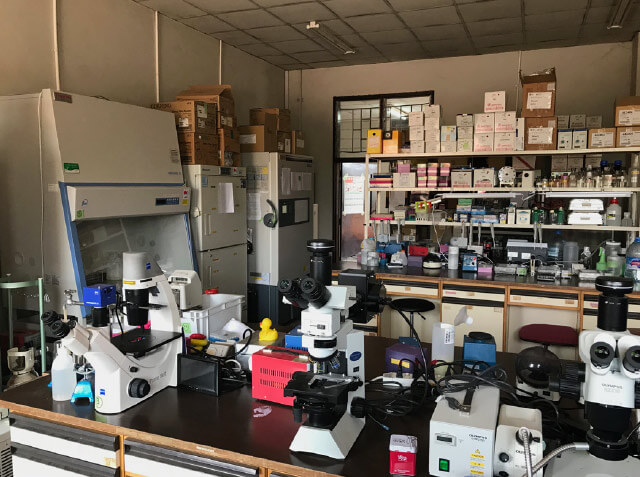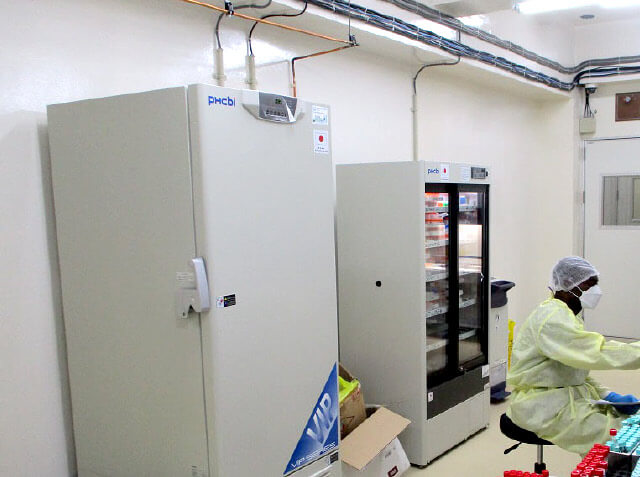Download Full Testimonial
Zambia, located in southern Africa, is far removed
from a country like Japan. The University of Zambia's School of Veterinary Medicine, established in
1983 with the Japanese government’s Official
Development Assistance (ODA) funding, is a leading educational facility for infectious disease
research in Zambia, a land rich in nature and
home to diverse wildlife.

(Center) Professor Ayato Takada,
(Left side) Assistant Professor Masahiro Kajihara
PHCbi products, which have been supplied to a number of ODA projects, are also being used in projects in Zambia. How are PHCbi products contributing to research results overseas? We interviewed the project leader, Professor Ayato Takada, and co-researcher, Assistant Professor Masahiro Kajihara.
Identifying animals that carry viruses
What kind of research is being done in Zambia?
Takada: In collaboration with the University of Zambia’s School of Veterinary Medicine,
we are conducting research on Ebola. The disease occurs locally in Africa and has caused several cross-border epidemics.
Fortunately, it has not yet appeared in Zambia, but we need to take preemptive measures.
Ebola is a zoonotic disease that occurs when a virus carried by wild animals infects humans.
Zoonosis cannot be prevented simply by controlling human behavior.
It is essential to identify the host that carries the virus.
Once we know where the virus is coming from, we can take effective preventive measures.
Currently, bats are the leading hosts of Ebola. In Zambia,
we first capture bats and then collect biological samples such as blood and organs.
We then examine the genes and antibodies to determine the presence or absence of viruses as well as the species of bat.
We have studied more than 1,000 bats in Zambia so far.
In addition to these studies, we are conducting
research on the development of diagnostic methods for Ebola.
This is the second phase of the SATREPS project.
In the first phase, we developed an Ebola virus diagnostic kit in collaboration with another company.
The diagnostic kit, which we are using in the second phase, is also being used in the Democratic Republic of Congo when an outbreak occurs.
PHCbi products provide behind-the-scenes support for SATREPS research
Setting up a laboratory at the University of Zambia's
School of Veterinary Medicine was not a straightforward task.
The team had to install air conditioners to prevent heat-related equipment from malfunctioning, and install airtight windows to prevent
sand from getting inside. They essentially had to start from scratch. Since the necessary products were not available in Zambia,
they had Japanese research equipment sent in. This included PHCbi products, such as ultra-low temperature freezers.

Laboratory at the School of Veterinary Medicine, University of Zambia
In what ways are you using PHCbi products in this project?
Kajihara: The pharmaceutical refrigerators are used for storing reagents and culture media for culturing cells.
They are also used to temporarily store PCR products for reading DNA and RNA sequences.
The CO2 incubators are used for cell culture. Viruses can only grow in cells, so we keep cells to grow viruses.
They are also used to culture hybridoma cells, which produce antibodies.
The medical freezers store reagents for PCRs and samples that do not need to be stored at ultra-low temperatures.
They also contain expensive reagents, so it would cause an issue if they broke down.
Ultra-low temperature freezers are also used to store animal tissue samples collected in the field and to preserve cultured cells.
Freezers kept at -80°C can store biological samples semi-permanently without damaging the genes of the samples while also maintaining the virus and cell activity.
That is why it is important that the equipment used in ODA projects is exceptionally reliable.
In this sense, I trust Japanese products such as PHC.
It has been 14 years since I bought an ultra-low temperature
freezer and sent it to the University of Zambia, and it is still working. They are very durable.
Kajihara: When I first arrived at the university,
I was surprised to find that Japanese equipment sent in the 1980s,
when the School of Veterinary Medicine was first established, was still in use (laughs).
It is a difficult task to go all the way to Zambia to catch bats and collect samples wearing full-body protective gear.
Don't forget that it took many years before we were able to collect samples in the first place.
Forty years ago, the University of Zambia established a veterinary school, set up a laboratory, and installed laboratory equipment...
A lot of sweat goes into getting a single sample.
If the freezer malfunctions, all the value that was held in the sample will disappear in a split second,
so we are very careful in selecting equipment and building a backup system.
What has been your experience of using PHCbi products?
Kajihara: The Zambian staff have been using the products in their own way.
It seems to be helpful that they are well-written in English. Personally,
I find the CO2 incubator’s dry heat sterilization function useful.
The buttons make it easy to operate and it seems to be easy for the locals to use as well.
I like the fact that the medical freezer’s defrost function can be operated separately by chamber.
Takada: I have been using these products since I was a student, so I’m very comfortable with them.
I like the fact that I can see what's inside the medicine cabinet door without having to open it, so I can
find and take things out easily. The size of the cabinet is also just right.
A veterinary school active in the fight against COVID-19
SATREPS is an international collaborative research program that aims to address global
issues by drawing out the capabilities and potential of developing countries while simultaneously
enhancing Japan's technological abilities. Professor Takada and his colleagues are working toward this goal.
What have been the effects of the project?
Takada: The surveys, research, and development of diagnostic and therapeutic methods for clinical applications are steadily progressing.
These efforts have also helped with training.
Thanks to the many years of joint research and exchange programs,
the University of Zambia has a large number of researchers who have studied at Hokkaido University and acquired technical skills
through joint research with Japanese teams.
It takes many years to develop strong teams, so we consider this to be a great achievement.
During the Ebola outbreak in West Africa in 2014,
the University of Zambia’s School of Veterinary Medicine served as a diagnostic center for patients suspected of contracting Ebola.
This is because it was the only institution in the country that had personnel with knowledge of the disease,
as well as the technology and equipment needed to perform genetic diagnoses.
The School of Veterinary Medicine also played an active role in the recent pandemic.
There were two institutions appointed by the Zambian government at the outset of the pandemic.
One was a leading laboratory for the study of human viral infections, and the other was the University of Zambia’s School of Veterinary Medicine.
Veterinary schools are usually in charge of animal diseases, so it was quite unusual for them to be in charge of testing human diseases.
That's how remarkable their success was back in 2014.
Kajihara: We have a good cycle in terms of staffing.
People near and far are coming to the University of Zambia to do research on viruses and infectious diseases.
I think there have always been people who want to do research, but until now they had to
go abroad to pursue their dreams. However, I am happy to see that the research base and employee
training is improving, and Zambian researchers are now able to teach the younger generations.
Takada: It took more than 30 years, but I am thrilled that we have finally come this far.
What are your future plans?
Kajihara: Right now, we are working with animal ecology researchers to attach transmitters to bats
and study them. What kind of life do bats lead?
What do they look for when they fly? If we can learn more about them,
we will be able to better understand the trends of the viruses that infect
bats. We hope to move forward with our research as soon as possible,
but it's very frustrating right now as we can't go to Zambia due to COVID-19.
Takada: The ongoing SATREPS project, "Project
for the epidemiological research on zoonotic virus infections in Africa," is a joint research project not
only with the University of Zambia, but also with the Democratic Republic of Congo’s National
Institute of Biomedical Research (Institut National de la Recherche Biomédicale) and others.
The laboratory in the Congo has just started up, so the relationships and research foundations are not yet in place.
There’s a lot to tackle going forward.
SATREPS is a five-year project, so it will end in 2023. However,
I plan to stay connected with Zambia whether there is another project like this or not.
We would like to get our own research funding and continue our research in the same way.
The goal of SATREPS is to "address global issues," and I like that concept.
As we saw from COVID-19, we cannot solve problems by only protecting our own countries or developed countries.
I hope that this will be an opportunity for many people to think on more of a global scale.

National Institute of Biomedical Research,
Democratic Republic of the Congo Installation of PHCbi equipment

Laboratoire Vétérinaire Central, Democratic Republic of Congo PCR Testing
PHCbi products are used in Zambia and the Democratic Republic of Congo, two countries that are quite far from Japan.
Given that environments and infrastructures differ greatly from country to country,
research equipment must not only be easy to use, but also robust enough to prevent problems.
This project, which aims to address the global problem of zoonosis,
is making steady progress thanks to the diligent efforts of researchers with excellent technical skills.
We look forward to the further development of research linking Japan and Zambia.
Supplied Equipment
·Pharmaceutical refrigerators
·CO2 incubators
·Ultra-low temperature freezers
·Biomedical freezers
·Cooled incubators
·Heated incubators
·Biological safety cabinets (SANYO)*
·Bioclean benches (SANYO)*
PHC Corporation, Biomedical Division
*Products marked with an asterisk (*) are currently not available outside of Japan.